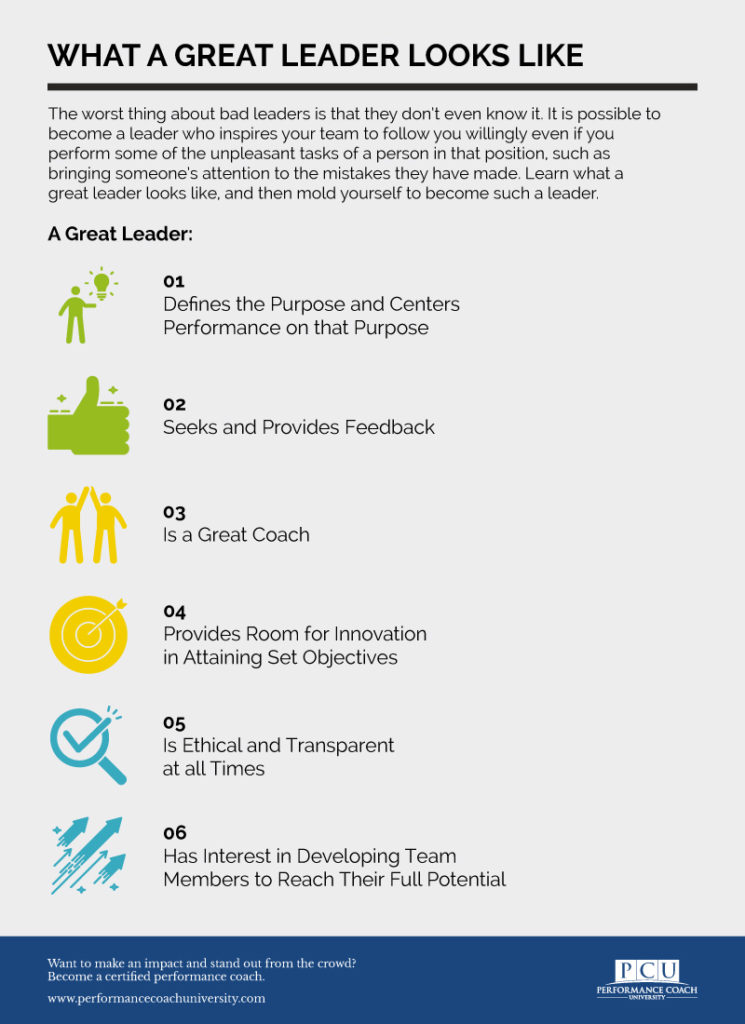The worst thing about bad leaders is that they don’t even know it. It is easy to imagine that people don’t just like you since it is your work to tell them what they should do. However, it is possible to become a leader who inspires your team to follow you willingly even if you perform some of the unpleasant tasks of a person in that position, such as bringing someone’s attention to the mistakes they have made. Read on and learn what a great leader looks like, and then mold yourself to become such a leader.
Defines the Purpose and Centers Performance on that Purpose
Every employee would like to know what is expected of him or her and to what end those tasks or projects are intended. Your success as a leader will depend on how well you can articulate the purpose of what your team is working on. You should also align each activity with this purpose so that everything works towards the attainment of the objectives set. In this way, each of your team members will feel that what they do has meaning, and daily tasks will be less boring.
Right Click To Save This Infographic!

Seeks and Provides Feedback
All employees, not just new hires, constantly want to know how they are doing and what else they can do to perform better. Providing feedback is therefore an important aspect of your work as a leader, and you will become a great leader if you excel at this task. Many companies have “mechanized” this important function into the annual performance reviews which employees view as an unavoidable but meaningless exercise.
Do things differently if you aspire to be a great leader. Give your direct reports feedback on an ongoing basis so that it is useful. For example, praise your employees when they perform exceptionally well. Cite the exact task, the date and time for the commendation you are giving. This concrete information will validate the employee and drive him or her to strive harder.
Remember, not all feedback has to be commendation or praise. Like all humans, the employees in your team (and you too) are prone to fall short and this needs to be pointed out. You don’t have to berate an employee for their mistakes in front of clients or other coworkers. Wait when you are alone and offer the constructive criticism with a view to correcting the behavior. A good rule of thumb to follow in this regard is that you should focus on the behavior and how it is detrimental to the company rather than on the individual. It is also helpful to first point out about 3-4 good deeds before you identify the area for correction. This balanced approach makes the team member more willing to make the desired change since they will regard your feedback as balanced and not seeking to victimize them.
Is a Great Coach
As already suggested, a great leader coaches his or her team to grow in all aspects. As a coach, you have a role to share your experiences, insights and ideas with your employees so that they can be empowered to take on bigger challenges on their own. As they grow, they will take on greater responsibility and perform at higher levels than they would if you hadn’t coached them to their full potential.
Related: What Is Performance Coaching?
Note that as you coach your team members, you shouldn’t impose your ideas or solutions upon them. Your suggestions are just eye-openers upon which the coachee can come up with their own solutions to any challenge they are facing. Even if that solution won’t work, give the team member a chance to try it and learn from their mistake. This is what growth is about!
Provides Room for Innovation in Attaining Set Objectives
Have you heard that younger people often make better managers than older people? This observation may be because younger people are not yet set in their ways and are therefore more likely to accommodate different methods of getting things done.
Regardless of your age, you can learn to be that leader who gives his or her team members an opportunity to exercise their creativity in getting the job done. If you selected the right people for your team, then there shouldn’t be a problem giving those people a task and then getting out of their way so that they find the best way to accomplish that assignment.

The team members will appreciate this professional freedom that you have given them and your rating as a great leader will increase since each member will derive more satisfaction from what they do. Of course you can still check in to see how they are faring, but don’t breathe down their necks every minute of the assignment.
Is Ethical and Transparent at all Times
A great leader is someone that the entire team looks up to. This doesn’t magically happen, but it results from the way the leader conducts him or herself. Great leaders never compromise their ethics and their teams know them for being transparent at all times. For example, you will never find a great leader throwing a direct report under the bus for something that the leader did. Instead, the leader owns up to his or her mistakes and takes steps to remedy the situation.
Similarly, great leaders always provide truthful information to the teams. For instance, a great leader will not lie that the company is in sound financial health when this isn’t the case. The leader knows that his or her team is vested in the future of the company, so he takes it upon himself or herself to keep them informed while encouraging them to stick to the mission even if conditions aren’t ideal. Employees will follow such a leader wherever he or she leads them.
Has Interest in Developing Team Members to Reach Their Full Potential
We have already mentioned that great leaders coach, provide feedback and give their teams liberty to find the most appropriate ways to get the job done. All this points to another attribute of these people; they are genuinely interested in developing each team member so that he or she reaches their full potential. Whether this nudge takes the form of suggesting what additional skills the employee can acquire or pushing them to take more responsibility at work, great leaders strive to develop their subordinates even if it ultimately means that they lose that team member to other pursuits outside the department or company. The growth great leaders want to see in their team isn’t restricted to that company alone, and this is why such leaders remain a strong influence in people’s lives long after their work relationship ends.
As you can see, becoming a great leader requires you to walk the talk rather than just pay lip service to your role as a leader. Start embedding the qualities above in everything you do on a daily basis until those attributes become second nature to you. As you progress on that journey, you will soon notice that the character of your team changes for the better to embody the example that you are providing. That may just be the motivation that you need to evolve even further!
To Your Success,
Jairek Robbins and Team PCU
Ready to level up your coaching and leadership game? Want to make a big impact in the lives of others? Add more power to your purpose with our 12-week online Performance Coach certification course. Apply here: Course overview & Application!
